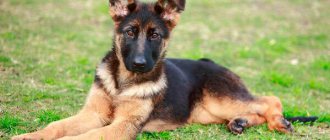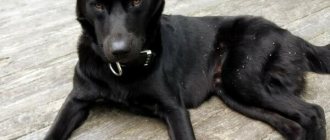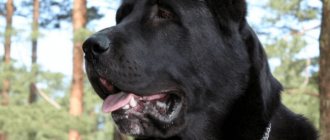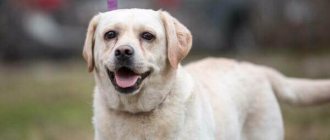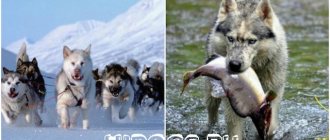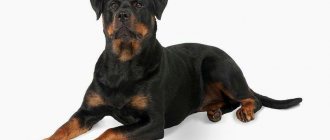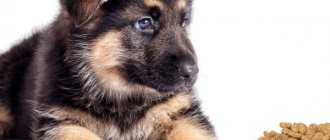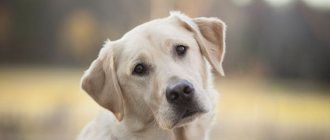Labrador is a kind, sensitive and loyal dog.
Serves his master faithfully.
The peculiarity of this breed is that they completely lack aggression.
Gets along well with children and other pets.
They adapt well to any living conditions.
What does a 3 month old puppy look like in the photo?
A healthy puppy looks well-fed, and there is no excess weight . The wool is particularly smooth and has a natural shine. The paws are strong and dense.
The molars erupt to replace the milk teeth . Provide your baby with safe chew toys to help relieve toothache.
Breed standards
The black retriever is a medium-sized dog, muscular, of proportional build. According to generally accepted breed standards, it must meet the following parameters:
- The height of an adult animal is 55-58 cm.
- Boys weight 28-36 kg, girls 26-32 kg.
- The body is medium in size, straight along the topline, with a strong neck and broad chest.
- Head. Not large, regular in shape, with a wide skull.
- The nose is wide, with pronounced nostril openings.
- The jaws are strong, slightly elongated.
- The eyes are brown or hazel in color and medium in size.
- The ears are small, drooping, and set far apart.
- The paws are strong and muscular.
- The tail is thickened at the base with a smooth narrowing towards the end. Doesn't bend over onto the back.
- Movements are light and free.
The black retriever is a medium-sized dog, muscular, well-proportioned.
Dog character
In the third month, behavioral characteristics can be compared with those of teenagers. He considers his family to be his pack, studies the internal hierarchy and tries to determine his place.
The puppy becomes more independent and tries to show dominance . You may notice how he questions power and authority.
The puppy may chew on the stick and ignore commands, but his attention is focused on your reaction. Be steadfast, tolerant and gentle. Your actions must be consistent, and your commands must be reinforced.
If your puppy bites or growls while playing, stop the inappropriate behavior and ignore it for a few minutes..
Do not fight with the puppy under any circumstances. This will make it clear that the fight is good and fun. Your main task is to instill in the dog the concept of obedience.
If the puppy becomes overexcited and aggressive, stop interacting immediately..
Hygiene
There is an opinion that large breed dogs have a characteristic odor, but this only happens when the owner does not pay enough attention to the pet’s hygiene. In order for a Labrador living in an apartment to be well-groomed, you need to regularly comb the pet’s fur, bathe it when it gets dirty, trim its nails and clean its ears.
If your Labrador exhibits lethargy, upset bowel movements, vomiting, skin rash, inflammation and suppuration of the eyes (ears) and other abnormalities, you should immediately show the dog to the veterinarian!
Popular articles Cats: description of all breeds
What is better – natural or dry food?
The puppy needs to be fed the food he is accustomed to from the breeder. Gradually add new foods and adapt the animal to a food system that is convenient for you.
A sudden switch to another food can cause food refusal.
At three months it is recommended to adhere to a balanced natural diet, and to resort to dry food only in rare cases when it is not possible to prepare nutritious food.
If you decide to completely switch your pet to dry food, then natural products must be excluded.
Specially formulated premium dry food contains all the necessary nutrients for the proper development of the puppy, and the presence of secondary food will upset the balance of nutrients.
This can cause liver and kidney diseases . Occasionally treat your puppy with fresh fruits and vegetables as treats.
Expert opinion
Kozhevin Semyon Kirillovich
Expert dog handler.
I recommend creating an individual balanced diet for your puppy from natural products. In the first half of the day, give milk and vegetable mixtures, and in the second - meat and canned food. Consider your pet's activity and food preferences. There is no need to force your dog to eat something it doesn't like.
Proper nutrition
A three-month-old puppy taken from a breeder should be fed for the first time in the same way as it was before it arrived in the house. And only after a few weeks switch to homemade food or ready-made food. But for this it is necessary to take into account such nuances as age, weight, degree of daily physical activity, and living conditions.
The puppy is fed 4–5 times a day, and the total amount per day should be about 400 grams.
You can choose two types of menu for your three-month-old pet.
Eating natural foods, including meat, cereals, vegetables, fruits and fish. At the same time, we must not forget: in order to avoid a deficiency of important elements and vitamins, the dog will have to be given various necessary supplements, liquid vitamins, calcined cottage cheese, and calcium as complementary food. You will also have to ensure that all products are of high quality and fresh. It is necessary to prepare for each meal separately, since food cannot be prepared for future use and kept in the refrigerator: this way it loses its valuable properties.
You can also feed your puppy dry food. Many people prefer this method because it is less expensive, both in terms of budget and time.
But nutrition with ready-made dry granules should be prescribed by a veterinary clinic doctor. Sometimes such a measure is necessary if the animal’s stomach is hypersensitive to many natural products or the dog has a tendency to develop allergies.
Modern industrial food from well-known brands can provide your pet with high-quality, impeccably balanced food, while premium nutrition includes special holistic, anti-allergenic products that are suitable for dogs with individual digestive characteristics.
Some owners choose a mixed type of food for their pet, according to the rules of which the dog receives dry food in the morning and eats natural food in the evening. However, this feeding method is only suitable for temporary use: mixing homemade products and dry food is a priori undesirable.
Basic feeding rules
Labradors quickly get used to the schedule set by the owner, so they need to be fed at the same time, leaving the bowl of food for 15 minutes. If the pet does not eat or begins to play, the food is removed. This is how you teach your dog to be disciplined.
You shouldn’t walk around with a bowl and try to persuade someone to eat . Otherwise, you will have to beg an adult dog later. Access to fresh water should be available at all times.
A puppy needs 2-4 times more nutrients than an adult dog of the same size, since the growth process is accompanied by high energy costs .
Three-month-old dogs eat a large amount of food in relation to their total body weight, but their stomachs are still small and can only accommodate frequent small portions.
Exercise stress
Labrador is an active and lively dog; puppies of this breed grow quickly, and in order for the baby to develop normally, he needs to walk for at least two hours every day, and also visit the training area.
If there is insufficient load, a growing baby Labrador, like a Cane Corso puppy , begins to spoil and chew things, make tunnels, and dig holes in the yard.
The ebullient energy must be given an outlet, but it is impossible to overload the Labrador by jogging behind the bicycle.
Willy-nilly, you smile while looking at a happy Labrador puppy running
A four-month-old puppy can already visit the training area and walk with the owner for an hour or two.
It is useful to walk up the stairs or up the mountain (but go down either by another route, or carry your Labrador in your arms).
Swimming in open water, running in shallow water - all this is very popular with Labrador babies, it strengthens their muscles and promotes proper development.
Natural food
The natural diet of a three-month-old Labrador includes products such as:
- milk;
- low-fat cottage cheese;
- minced meat and fish;
- porridge;
- vegetables;
- soft cartilage.
Prohibited Products:
- raw river fish;
- raw chicken meat;
- fried pork and beef;
- lung;
- sausages, sausages, hard bones;
- pearl barley, semolina, millet cereals;
- legumes (beans, peas);
- smoked, salted, pickled, spicy;
- sweets (chocolate, pastries, cakes).
In the daily diet, cereals make up 1/3 of the total volume, the rest comes from meat and dairy products. Prepare a fresh portion for each meal.
NOTE!
Do not serve food that is cold or too hot. Food should be at room temperature.
The puppy is fed 4 times a day.
The approximate feeding schedule looks like this:
- 7:00;
- 12:00;
- 17:00;
- 22:00.
Menu for the week
| Product group | Menu |
| Dairy | Goat's milk, cow's milk, low-fat cottage cheese, kefir. |
| Meat and fish products | Boiled chicken, beef, lamb, cod or pollock meatballs. |
| Porridge | Buckwheat, rice, wheat, crushed oatmeal. |
| Other products | Vegetables, fruits, herbs, egg yolk, soft veal bones and cartilage. |
How much to give?
The amount of food is individual and is calculated based on the weight and activity of the puppy.
Observe your pet's eating behavior. If after eating the dog greedily licks the empty bowl, it means the portion is not enough.
If the stomach looks bloated and tight, then the amount of food should be reduced . Labradors are prone to obesity, so don't overfeed your puppy with carbohydrates.
Average daily servings:
| Products | Weight |
| Meat | 350 gr |
| Cottage cheese | 100-150 gr |
| Porridge | 150 gr |
| Milk | 300 gr |
| Kefir | 300 gr |
Approximate daily diet
- Breakfast : low-fat cottage cheese 100g + kefir 1% 50 ml + 50 g porridge
- 2nd breakfast : 100 g of porridge + vegetables, 100 g of greens;
- Lunch : meat (fish, poultry) 120 g + vegetables, greens 100 g;
- Afternoon snack : low-fat cottage cheese 100 g + kefir 1% 100 ml;
- Dinner : meat 130 g + vegetables, greens 100 g, egg (1-2 r per week per week)
Vitamins and supplements
There is no consensus on an additional vitamin-mineral complex . The amount and type of supplements a puppy needs for normal development and functioning are prescribed by a veterinarian.
CAREFULLY!
It is not recommended to give calcium as it can cause problems with baby teeth falling out.
Dangerous insects
After each walk, you need to inspect your pet's fur for ticks. By brushing your dog, you will remove not only loose hair, but also some of the attached insects. Ticks that have already sucked will fall off on their own. And those that hold tightly must be carefully removed.
Lubricate the tick with vegetable oil to limit its access to air. After 15-20 minutes it should fall off on its own. If this does not happen, then use tweezers or thread to pry the tick and begin to twist it out. Be careful that the insect's head does not remain in the skin. If you are not confident in your abilities, it is better to consult a doctor.
The presence of fleas in an animal is very easy to determine. Black crumbs (products of their vital activity) appear in the wool. And on the stomach, in the armpits or on the inside of the hind legs you can find bite marks in the form of red spots. Special sprays, powders, drops that can be found at the pharmacy will help get rid of fleas. Among domestic ones, these can be “Bars” or “BlochNet”, among imported and more expensive ones - “Frontline” or Hartz. It is necessary to treat not only the dog’s fur, but also the room where it lives, especially the kennel and rug.
Feeding dry food
Dry food for a puppy is selected based on age and nutritional characteristics. Quite often, Labradors have an allergic reaction to components in the food.
This does not mean that the food is bad, just that it is not suitable for your pet . In such cases, it is necessary to contact a veterinarian, find out the cause of the allergy and choose the appropriate food.
How to choose?
Experts do not recommend choosing budget brands.
Economy class feeds contain insufficient nutrients, which means they will not be able to meet the needs of a growing organism . Cheap food is more likely to cause allergies.
Classic hypoallergenic foods are those consisting of lamb meat, rice, and sea fish. High-quality feeds are included in the “premium” class and higher.
You should pay attention to the amount of proteins in the composition . High protein intake is not recommended for Labradors.
Take a closer look at manufacturers such as:
- Acana;
- Orijen;
- GO;
- Now Fresh;
- Hill's;
- Purina Pro Plan.
Information on how many grams of dry food to give your puppy per day can be found on the packaging, taking into account the individual characteristics of your pet.
Master's Code
A loyal friend, companion, assistant - that's all he is, a Labrador; caring for and keeping a representative of the breed at home can seem quite complicated. This is an active dog that needs to run around and splash out its energy. In addition, due to its considerable size, it consumes quite a lot of feed.
Labrador is an excellent companion and faithful friend for many years
For your information! Those owners who decide to stick to natural food will have to cook especially for the dog, and in large portions.
Before you make the final decision to become a Labrador Retriever owner, you should familiarize yourself with the following owner code:
There are no bad dogs. There are unscrupulous and irresponsible owners; The standard life expectancy of dogs is 12-18 years. All this time he will need to be taken care of, walked every day, regardless of the weather and health; an animal is not a toy that you can get rid of if you decide you’re tired of it
This is a living creature with its own character and habits; it's important to be consistent. The cute antics of a puppy who loves to affectionately bite his owner’s legs will no longer be so touching as he grows up.
Therefore, from early childhood, all prohibitions are practiced clearly. If you can’t, then you can’t forever; training and training should be carried out according to the principle from simple to complex. A “carrot and stick” policy without physical violence and aggression is the choice of a responsible owner. “Whip” in this case is a stern tone, a demonstration of displeasure; The dog's nutrition is the responsibility of the owner. A dog is not a pig, waste from the human table is not suitable. They either prepare it separately or buy ready-made industrial feed; The veterinarian is a specialist whom you will have to get to know. Preventive examinations should become a good habit. It is better to prevent any disease than to treat it.
These are the main points that a Labrador owner should consider.
The Labrador will become a true friend to its owner, but needs proper training
Do I need to get vaccinated?
At 3 months, the puppy receives a mandatory vaccination against canine distemper, infectious hepatitis, parvovirus enteritis and canine parainfluenza: Nobivac DHPPi + Nobivac Lepto or Eurican DHPPI2-L.
10 days before vaccination, treatment against worms is required, and after vaccination the animal must be quarantined for 14 days.
Useful video
From the video you will learn what a Labrador puppy looks like at 3 months:
Rate the author's article:
3 ratings, average: 5.00 out of 5
Loading…
The Labrador breed is one of the most popular and beloved. There is a simple explanation for this - the dog has all the necessary service and wonderful personal qualities, it is friendly, cheerful, flexible, and amenable to training. This is a cheerful and faithful assistant to a person in all matters, but in order to raise and raise a puppy, you will need to learn everything about the characteristics of the animal.
Caring for a three month old puppy
Labradors, by their nature, are particularly clean, so they do not need any special care. The coat of these dogs is short and smooth.
You can comb it 2-3 times a week.
If the puppy rarely goes outside and does not spend much time there, then he should be bathed less often than an adult dog . After a walk, wipe their paws with a damp towel.
Nail trimming occurs as needed, and if the puppy spends most of its time outdoors, the claws will grind down on the asphalt.
The animal’s ears should be cleaned once a week with a cotton pad, and the eyes should be wiped with a damp swab in case of visible dirt..
When to wean from the bitch?
Labradors are large, often multiparous dogs.
If there are many puppies in the litter or the bitch has little milk, then it is often necessary to wean early, at 21-25 days. If there is enough milk, the puppies can continue to suckle their mother for up to 1.5–2 months.
If the bitch had a caesarean section, was treated with antibiotics or on the recommendation of a veterinarian, the puppies may be weaned earlier.
Training and education
Labradors are easy to train. The behavior of the puppy directly depends on the owner - the leader of the pack, who dictates the rules. Punishment for an offense is accepted if it follows immediately after the action. Correct execution of the command is immediately rewarded.
The puppy is taught that the owner has the right to a toy and food . Any aggression towards a family member must be stopped.
Some time after sleeping, eating or playing, the puppy is taken outside, teaching him to relieve himself outside the house. Until the puppy has learned to control his body, scolding him for puddles is useless.
If you adhere to the rules, then gradually the dog will begin to ask to go outside on its own, for which you need to praise.
During a walk, immediately stop attempts to tug on the leash with a jerk and the command “near!”, and after a few meters the command “walk” is accompanied by freedom for the length of the leash.
At home, the puppy is taught not to bark for no reason, not to climb on the bed, and not to take food outside the bowl.
At 3 months, the puppy should know his name and master the following commands :
- "Ugh!";
- "Place!";
- "Lie!";
- "Sit";
- "Near!";
- "Go for a walk."
Every year there are more and more fans of Labradors all over the world.
The breed is particularly loyal, flexible, kind and trainable . These dogs have practically no negative qualities, while combining a huge number of advantages.
How to stop biting?
All puppies have very different personalities and each of them has special features..
They grow up calm or mischievous, aggressive or kind, proud or funny. Many owners are faced with the problem that their pet bites. Of course, this is natural for them.
However, there are several methods that will help wean your pet from this habit.:
- Toys . Try using a rubber ball as a distraction. Every time you see that your pet is about to bite you, slip him a toy instead of your hand. This way, the puppy will understand what he can and cannot bite.
- Swearing and punishment . Each owner makes his own decision on how to raise his dog. However, it is better not to scold or punish the dog, as these actions can have a bad effect on the puppy’s psychological state. He may become aggressive or constantly in a bad mood. It is best to accustom him to the commands “Fu!” and “You can’t!” Then the puppy will understand that it is forbidden to bite.
- Ignoring . In fact, this is a very effective way. The dog is a very sensitive animal, so punishment such as ignoring it will have an effect on it. She will very soon stop biting so that she will never lose her owner’s favor again.
So, if you are planning to get a Labrador puppy, then this article will help you prepare for the presence of a new family member in your home.
How much does a Labrador Retriever cost?
The most affordable offers are “hand-off” puppies, without documents and pedigree, but we remind you once again: this way you risk becoming the owner of a dog with poor health or completely devoid of the “trademark” qualities of a Labrador due to the admixture of unknown genes.
A child with papers who cannot count on participation in exhibitions due to more or less significant defects in appearance will cost 50 thousand rubles. Of course, this moment does not matter if you just dream of an affectionate and devoted friend for the whole family.
Dogs of the so-called show class, whose parents are recognized champions, and whose characteristics exactly correspond to the breed standard, are much more expensive - in the range of 60-80 thousand rubles. In this case, you will be able to present your pet to a strict court of experts and hope for prizes.
Dangerous insects
After each walk, you need to inspect your pet's fur for ticks. By brushing your dog, you will remove not only loose hair, but also some of the attached insects. Ticks that have already sucked will fall off on their own. And those that hold tightly must be carefully removed.
Lubricate the tick with vegetable oil to limit its access to air. After 15-20 minutes it should fall off on its own. If this does not happen, then use tweezers or thread to pry the tick and begin to twist it out. Be careful that the insect's head does not remain in the skin. If you are not confident in your abilities, it is better to consult a doctor.
The presence of fleas in an animal is very easy to determine. Black crumbs (products of their vital activity) appear in the wool. And on the stomach, in the armpits or on the inside of the hind legs you can find bite marks in the form of red spots. Special sprays, powders, drops that can be found at the pharmacy will help get rid of fleas. Among domestic ones, these can be “Bars” or “BlochNet”, among imported and more expensive ones - “Frontline” or Hartz. It is necessary to treat not only the dog’s fur, but also the room where it lives, especially the kennel and rug.
